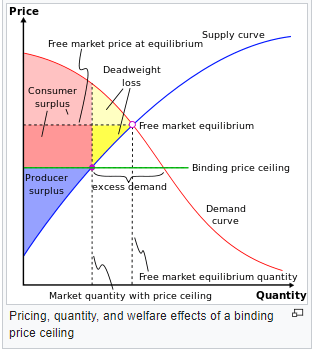What is Price Ceiling in Economics and Its Implications? A price ceiling is price control, limiting how high a price can be charged for a product or service.
What is Price Ceiling in Economics and Its Implications:
Price under the ceiling is legit as long it does not cross it.
Price Ceiling Implications:
A price ceiling is a mechanism created by the government to protect consumers from conditions that could render price prohibitively expensive as well as protect the business administration to manage the cost at a balanced level
Price ceilings can be demonstrated graphically.

Assuming the case in this swiftly progressing world, the world pays gonna support the purchase of vehicles and interest movements to achieve the goal of maintaining the market price of 3.50$ per gallon indicated as P0 in fig.
The fast increasing prices of fuel create a burden on the low end and direct wage family units which bear the burden of government as well.
To maintain the gas price to 3$ the authorities enforce the ceiling price of 3$ per gallon
The price ceiling must be under the equilibrium pricing to create an impact on the market
Establishing 4$ as ceiling price will hold no effect on the market in the current scenario.
Read Also: Market Models and 4 Types of Market Structures.
What will be the impacts of this $3 ceiling price? Impacts of Price Ceiling Implications:
Free market proportioning capacity is made incapable. there is a persistent deficiency of gas as the ceiling price Pc is beneath the P0 (market-clearing price).
at Pc, Qd is the amount of fuel requested and Qs is the amount provided. deficiency of sum or A constant oversupply request Qd – Qs happens.
Pc (price ceiling) keeps rivalry among purchasers and offers up the price by creating a typical market change.
This will Initiate more generators and proportionate a few purchasers out of the market.
That mechanism would typically go on till the point when the lack disappears at the harmony price and amount, P0 + Q0.
By keeping these market changes from happening, the price ceiling addresses two related issues.
What If Price Ceilings Implications Go Wrong?
There are many types of research that show that under a few conditions prices can become unstable and may lead to higher prices.
The main point is that the price ceiling serves to manage things among providers who may somehow contest prices.

All the more absolutely:
Forming a cartel is advantageous, enlightening the fact that it empowers apparently contending firms to work according to the business model, forcing amounts and raising prices.
In any case, framing a cartel can be a pain considering the fact that it is important to agree on the amounts and prices.
Considering the grounds that every firm will have a driving force to “cheat”.
That in turn will offer more agreement by bringing down prices.
Antitrust laws make Changes significantly more irritating due to lawful approvals.
It will be very simple for an organization to accept an independent controller report which has implemented extreme prices.

Case Study For Price Ceilings:
Let’s take an example of Pakistan when the Government (PTI) decided to set a ceiling price of Petrol at Rs.60/litre to accommodate the nation. But the results were totally opposite.
The oil companies working in Pakistan refuse to deliver Petrol at such a low price as they argue that it will cost them more.
Due to which there was a huge shortage of Petrol all over the country and the Government was also not in such a Financial Position to Import Oil to meet the demand at a low price.
So, the whole point of understanding is that price ceilings can be Profitable if implemented properly.






















